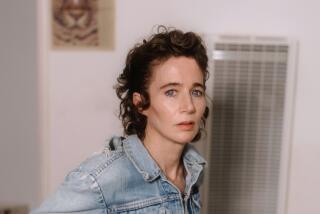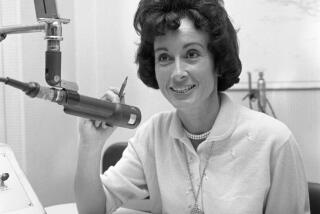It’s Come a Long Way, Maybe : Ladies Home Journal of Today Differs Considerably From the 1920s Version
- Share via
I HAVE RECEIVED an amiable letter from Myrna Blyth, editor-in-chief of the Ladies’ Home Journal, in response to a recent column about a September, 1920, Journal I found in my garage. From that old issue I concluded that life for the American housewife in 1920 was a kind of “benign imprisonment” from which her only main hope of escape was the washing machine and the vacuum cleaner.
“Life for women in the second decade of this century was difficult, as you point out,” Blyth says, “though I would imagine the women who were reading those advertisements for Crystal Electric Washer and Wringer and Libby’s canned meats felt fortunate.
“In September, 1920, they believed they had more options and opportunities than women ever had before--and they had.” I believe that both those statements are true.
Blyth notes that the Ladies’ Home Journal is far from history, having just concluded its most successful year, with a circulation of 5 million and more than 16 million readers.
She enclosed a copy of the September, 1990 Journal. Its cover alone dramatizes how the American woman’s existence has changed in 70 years. The 1920 cover showed a demure young woman under a parasol, flanked by two attentive young men. Her skin was the color of pink rose petals. There was no text.
Elizabeth Taylor gazes out from the cover of the current issue in utter imperturbability, dark fringe bangs falling over hypnotic eyes. Light shines on her dark-pink lips. The message is clear. One need not grow old.
Eleven separate stories are promoted around Ms. Taylor’s head and shoulders, including her own new discovery that “to live each day fully is a gift.”
Some reflect woman’s eternal longing for beauty: “Thin Thighs Three Ways;” “Why Women Get Addicted to Food;” “Busy Moms’ Beauty Boosters;--articles that might very well have been in the 1920 issue.
Today’s greater freedom is expressed in such titles as “Virgin Wife: In Sixteen Years We’ve Never Made Love,” and “What Makes a Smart Woman Sleep with Her Boss?” I read the one about 16 sexless years of marriage and agreed with the author that what that couple needed was some good counseling.
I also read “What Makes a Smart Woman Sleep with Her Boss” and was not surprised when its author concluded that a woman who sleeps with her boss is not being very smart.
But the ads were most revealing. In 1920 women were advised to use various oils, powders, creams, unguents, soaps and such deodorants as Odorono and Mums; but in 1990 the accent is on lipstick, skin conditioners and scents. The first eight pages are a pullout ad for Revlon’s new Velvet Touch Lipstick. It features a brown-eyed young woman with dark skin, brown eyes, heavy arched eyebrows, and a little mole or beauty mark above the left corner of her mouth.
Perhaps the most striking difference, though, is in the housework machine ads. In September, 1920, the Journal had three ads for cooking ranges, three for electric washers, one for a sewing machine, one for a carpet washer, one for an ironer and six for vacuum cleaners. The only appliance ads I find in the 1990 issue are two for vacuum cleaners and one for a washing machine.
Perhaps too much should not me made of that. Women are still dependent on such work-lightening machines, but in 1920 they were not so common. Perhaps there is not enough new business to attract advertisers. On the other hand, people get married or move in together and take up housekeeping every day. I don’t see how a couple can live together without a vacuum cleaner. Maybe that was the problem with that couple who lived in marriage for 16 years without a consummation. Maybe they didn’t have a vacuum cleaner.
The new Journal has the usual sections on parenthood, healthful recipes and fashions, just as the 1920 issue did. In both decades the fashions seem to be fantasy garments that beguile the eye but that one is never likely to see on a woman one knows. (Perhaps I don’t move in fashionable circles.)
I wondered in my critique of the 1920 issue what my mother would be like, with her artistic yearnings, if she had been 30 today instead of in 1920. Blyth comments: “Although one can never know what one’s mother would be like if she were 30 today, I trust she would be reading Ladies’ Home Journal and be informed and entertained by its contents.”
Maybe so. But I doubt that my mother would read an article called “Virgin Wife: In Sixteen Years We’ve Never Made Love.” My mother was reticent about sex.
But that misses the point. Today, of course, she’d be a modern woman.
She’d might use Revlon Velvet Touch lipstick and wear her hair like Elizabeth Taylor in stringy bangs, but she’d never sleep with her boss.
More to Read
Sign up for Essential California
The most important California stories and recommendations in your inbox every morning.
You may occasionally receive promotional content from the Los Angeles Times.













